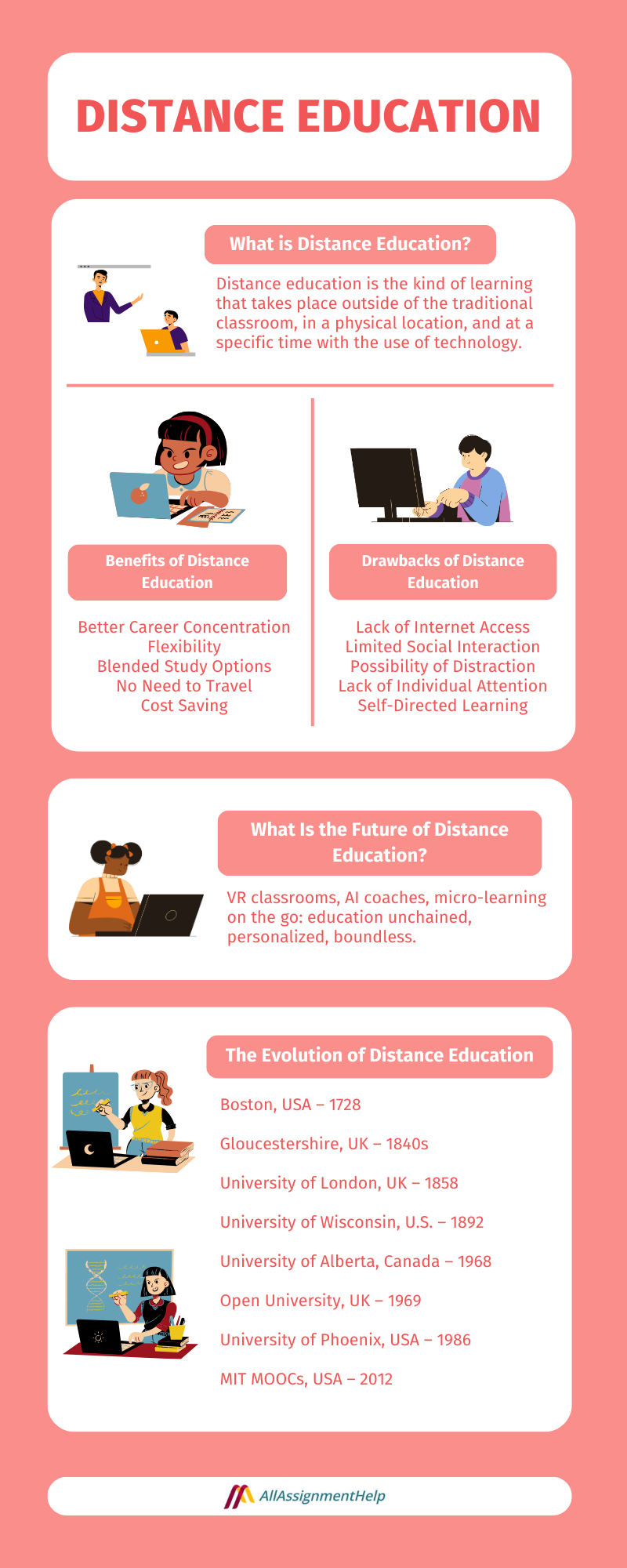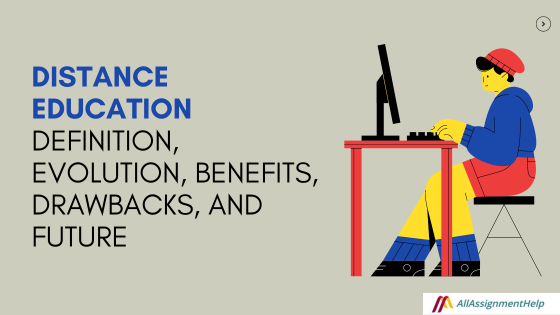Table of Contents
Distance education has been around for a while, allowing students to take and learn from academic courses without physically being present at a school or university. The number of students enrolling in online courses increased dramatically during the pandemic. Many academic organizations, including universities, have made distance education available to their students. Now, distance learning programs are available for undergraduate, graduate, and professional studies. Colleges and universities ensure that the qualifications and programs offered through distance learning are on par with those offered on campus. However, it’s critical to understand this education strategy thoroughly before enrolling in an online learning education. In this blog of All Assignment Help, we will give insights into distance education from its evolution to the future along with sharing its benefits and drawbacks.
What is Distance Education?
Distance education is the kind of learning that takes place outside of the traditional classroom, in a physical location, and at a specific time with the use of technology. As a term, it describes courses that can be taken online without requiring students to attend classes in person at a school, college, or university.
In the past, correspondence courses were available for distance learning at high schools and universities. Furthermore, students received their course materials via mail often, and they had to finish their assignments online or send them back to their teachers via mail.
In recent times, distance education programs have embraced the remarkable prospects provided by contemporary technology to provide highly personalized and efficient learning experiences across a wide range of distance learning courses. This also gives rise to the services that offer online class help to students pass their distance education course with flying scores.
Read Here: How to Excel in Online Learning Courses: Top Tips to Follow
The Evolution of Distance Education
The advent of distance learning is one of the many significant changes that education has experienced over the millennia that it has been in existence. However, it can appear to be a contemporary innovation based on the internet, distance education has been around for more than three centuries in various forms.
Boston, USA – 1728
The introduction of distance learning preceded the development of the Internet. The earliest documented instance of remote learning took place in Boston in 1728, one of the British North American Colonies. These classes taught shorthand, a quick writing technique that substitutes symbols and acronyms for words.
Gloucestershire, UK – 1840s
Sir Isaac Pitman started providing shorthand correspondence courses in the 1840s, over a century later. Pitman gave feedback to his students by grading, editing, and returning their work, which set his course apart from Caleb Philipps’. Nowadays, reporters, secretaries, and court stenographers still use Pitman Shorthand extensively for note-taking.
University of London, UK – 1858
The University of London began offering degree programs through its External Program in 1858, enabling students from outside of London to pursue degrees from the university. Since then, students all around the world have been able to obtain course materials and return assignments via mail, significantly boosting the popularity of long-distance education.
University of Wisconsin, U.S. – 1892
The phrase “distance education” was initially adopted by the University of Wisconsin in 1892. Then, they started handing out photographs to their students and recording lectures in 1906. The university began offering doctors telephone-based teaching in 1965.
University of Alberta, Canada – 1968
1968 saw the introduction of some of the earliest distance learning programs by the Department of Medicine at the University of Alberta in Canada. However, these courses attracted almost 20,000 students which taught 17 classes over the IBM 1500 network. Additionally, this system was used by teachers to organize documents, grade assignments, and distribute course materials remotely.
Open University, UK – 1969
In 1969, the Open University was established by the UK Labour administration, headed by Harold Wilson. This emerged as the initial establishment dedicated to providing online education. It was made to give those who had previously been unable to attend college and earn a degree the chance to pursue higher education.
University of Phoenix, USA – 1986
The University of Phoenix was the world’s first academic institution to launch a fully online collegiate program. Furthermore, this program increased public accessibility to advanced learning by offering both bachelor’s and master’s degrees.
MIT MOOCs, USA – 2012
The Massachusetts Institute of Technology (MIT) introduced MOOCs (Massive Online Open Courses) in 2012 as part of their MITx initiative. This allowed the educational organization to provide free access to online learning resources and a portfolio of its courses.

What Is the Future of Distance Education?
Although distance education has been around for decades, its use has increased significantly since 2020 due to the COVID-19 pandemic and the widespread availability of internet connections.
Now, it is evident that being physically present in a classroom is not the sole way to facilitate good learning. However, distance learning has advanced significantly for students ranging from elementary school to universities and colleges with no signs of slowing down.
Moreover, workplaces have continued to implement distance learning strategies in conjunction with the growth of remote and hybrid work. Additionally, with learning management systems and readily integrated technologies for producing educational content, it is simpler than ever to deliver high-quality education in the workplace, regardless of distance.
Finally, distance education is an excellent tool that will continue to be developed and used in an increasing variety of circumstances, even though it is unlikely to completely replace classroom instruction.
Also Read: Online Education: The Most Effective Way to Learn New Skills
Benefits of Distance Education
Compared to traditional classroom-based education, distance learning has several benefits, such as:
Better Career Concentration
Online degrees have positive professional effects for employers and students. Individuals who are employed can enhance their skills without quitting their current position and essentially invest in their future professional growth. Moreover, individuals who are just beginning their careers might receive a quick knowledge boost that will make it simpler for them to land a suitable job.
Flexibility
Distance education programs are preferred by many self-disciplined and extremely motivated learners. They operate well in the online environment and are well-organized. It gives individuals the freedom to learn at any time and from any location. Furthermore, students have the opportunity to hire someone to take my online exam for me as well and this has become possible because of the flexibility that distance learning offers.
Blended Study Options
It’s not necessary to teach everything online for distance learning. Most classes for Master’s degrees in blended learning are offered online, but normal on-campus classes must still be taken at scheduled times. In this way, students who aspire to have an international experience and avoid the financial burden of living abroad won’t be left behind.
No Need to Travel
There is no need to travel to a campus for distance learning. Distance learners can virtually visit museums, real-world venues, planetariums, and other locations simultaneously. Moreover, students who participate in distance learning programs find virtual travel to be enjoyable.
Cost Saving
Distance education tends to be less expensive than regular programs as they don’t charge for housing and board, transportation, or other associated costs. This means you don’t have to worry about how long it will take you to get to class or how much it will cost. there are fewer administrative expenses than with in-person classes. Therefore, course materials and tuition may be less expensive as well.
Drawbacks of Distance Education
While there are many positives to distance education, there are also certain drawbacks associated with this kind of teaching. Let’s talk about a few drawbacks.
Lack of Internet Access
This is one of the main drawbacks of online learning, particularly for learners. One of the main reasons schools are still unwilling to adopt virtual education is a lack of internet access. Moreover, concentration is difficult when your internet in the classroom keeps lagging or losing connection.
Limited Social Interaction
Compared to the traditional educational model, the amount of social networking and collaboration provided by distance learning activities is significantly less. Students lose out on the opportunity to collaborate with peers directly when they are not required to attend a physical location.
Possibility of Distraction
Students participating in distance learning programs can discover distraction to be a problem. This can take many different forms. For example, students are more likely to become distracted online. However, they may become disconnected and lose motivation if they don’t have in-person meetings.
Lack of Individual Attention
The largest drawback of online education is the absence of in-person interactions with professors and fellow students. You might feel alone when taking classes online. However, a lot of professionals are enrolling in online programs from their places of employment and taking classes alongside their coworkers.
Self-Directed Learning
The main focus of distance learning is self-directedness. Although it’s not for everyone, self-directed learning has the potential to help you become an independent learner. Online degrees provide the necessary information and resources to acquire a certain skill set for your professional growth, but there is a compromise.
Also Read: How Technology can Simplify Learning
Final Thoughts!
Distance education offers an adaptable and convenient choice for students seeking to further their education. However, students can balance their academic and other responsibilities with the right curriculum and with the correct support. You can achieve your ambition of a higher education through this option regardless of who you are, where you live, what your prior qualifications were, or how well you scored. All you need is a strong will and the requirements to be eligible.
Furthermore, if you need any help with your online distance program, you can get in touch with us. We have online class helpers available from all academic domains to help you. Therefore, whether you need someone to take your online psychology class, accounting class, or English class, we have experts to deal with them all.
FAQs
| What is the main goal of distance education? The primary goal of distance education is to encourage students who are unable to attend regular schooling because of financial, geographic, or other limitations. |
| Why is distance learning preferable? Students enrolled in distance learning courses can complete their studies at their speed. This flexibility is especially helpful for self-motivated students who would rather speed through content they already know or take their time on more difficult subjects. |
| Can a distance degree be helpful? Some believe that the corporation does not appreciate distant learning degrees. The truth is that qualified applicants only receive job offers if their degrees are recognized by reputable universities. |
